What is a Karyotype?
All species are characterized by a set of chromosomes to carry their genetic information. The chromosomal composition of each species has a number of characteristics. The Karyotype is a set of characteristics that identifies and describes a particular set of chromosome. These characteristics which are described by a karyotype are:-
(1). The chromosome number
(2). Relative size of different chromosomes
(3). Position of centromere and length of chromosomal arms
(4). Presence of secondary constrictions and satellites
(5). Banding pattern of the chromosome
(6). Features of sex chromosomes
What is Karyotyping? How to Prepare the Karyotype of Human?
Ø The process of preparation of the karyotype of a species is called Karyotyping.
Ø Karyotyping is now most commonly used in clinical diagnosis and clinical genetics.
Ø Karyotype is prepared from the microphotographs of metaphase chromosomes.
You may also like NOTES in...
BOTANY BIOCHEMISTRY MOL. BIOLOGY
ZOOLOGY MICROBIOLOGY BIOSTATISTICS
ECOLOGY IMMUNOLOGY BIOTECHNOLOGY
GENETICS EMBRYOLOGY PHYSIOLOGY
EVOLUTION BIOPHYSICS BIOINFORMATICS
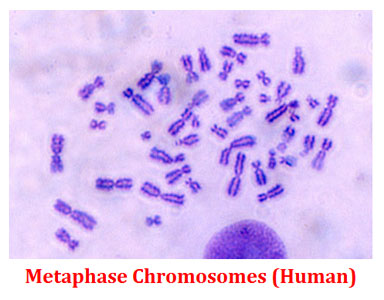
Ø The metaphase chromosome is selected because at this stage the chromosome will have maximum condensation (maximum thickness).
Ø At metaphase stage, the chromosomes will be visible through an ordinary laboratory microscope.
Ø For the clinical karyotyping, the sample materials used may be cells from biopsies, bone marrow cells, blood cells or cells from amniotic fluid or chorionic villus.
Ø The sample cells were first cultured on artificial medium with suitable growth regulators.
Ø The then the cells are arrested at their mitotic metaphase phase by treating with Colchicine.
Ø Colchicine will arrest the cells at metaphase stage since it prevents the formation of spindle fibres.
Ø In the absence of spindle fibres, the metaphase stage cannot proceed to anaphase.
Ø Then the cells were fixed with suitable fixative and treated with specific stains to produce characteristic banding patterns in the chromosomes.
Ø Specific staining or banding techniques are used to identify the homologous pairs of chromosomes within the cells.
Ø Cells are then observed through the microscope and the photographs of the chromosomes were taken.
Ø The individual chromosomes are cut out from the microphotographs and then they are lined up by size with their respective partners to form the karyogram
Ø A uniformly accepted pattern is used for the arrangement of chromosomes in the preparation of karyogram.
Ø In a karyotype, the chromosomes of the organism are ordered in a series of its decreasing size (largest chromosome at first and smallest at last).
Ø In the case of human, the autosomes are numbered from 1 to 22 and arranged in the order of decreasing size.
Ø Sex chromosomes are arranged after the autosomes.
Ø Chromosomes in the karyogram are aligned along a horizontal axis shared by their centromeres.
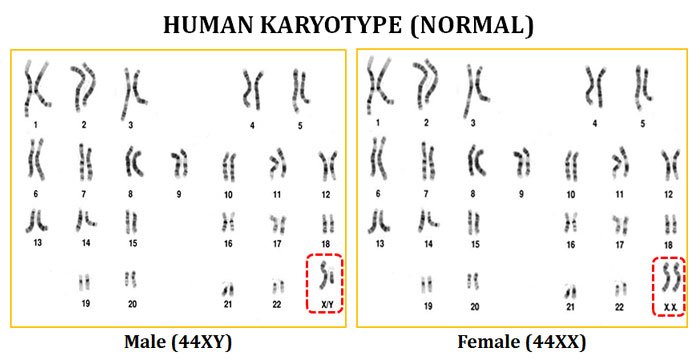
(image source: wikipedia)
Ø Individual chromosomes are always depicted with their short ‘p’ arms at the top, and their long ‘q’ arms at the bottom.
Ø The centromeric index is also noted in karyotype analysis.
Ø Centromeric index is the ratio of the length of long and short arms of the chromosome.
Learn more: Classification of Chromosomes based on position of Centromere and Length of Chromosomal Arms
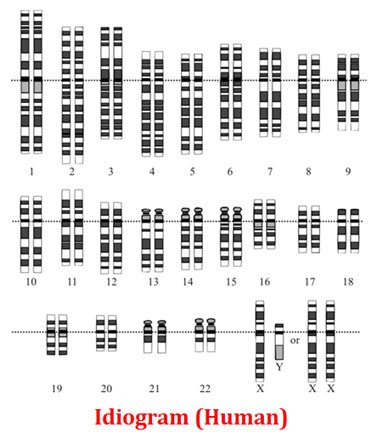
(image source: wikipedia)
What is an Idiogram?
Ø The diagrammatic representation of a karyotype of a species is called Iiogram.
What are the Significance / Importance of Karyotype and Karyotyping?
Ø Karyotypes of different species can be easily compared.
Ø Similarities in the karyotypes represent the evolutionary relationship.
Ø Karyotypes can be used to solve taxonomic disputes.
Ø The karyotype can indicate primitive and advanced features of an organism.
Ø The karyotype of an organism may be symmetric or asymmetric.
Ø A symmetric karyotype possesses more or less similar sized and shaped chromosomes.
Ø An asymmetric karyotype will have huge differences in small and large chromosomes and contain less metacentric chromosomes.
Ø A symmetric karyotype is considered as primitive whereas, an asymmetric karyotype is considered as advanced.
Ø The zygomorphic flowers in plants are associated with asymmetric karyotype.
Ø Some species may have special characteristics in their karyotypes such as mouse has acrocentric chromosomes and many amphibians have only metacentric chromosomes.
Significance of Clinical Karyotype and Clinical Karyotyping of Human Chromosomes:
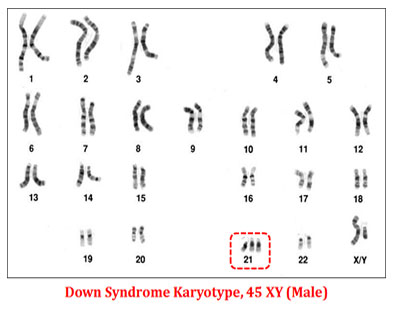
(image source: wikipedia)
Ø Nowadays, the Karyotyping frequency used in clinical diagnosis.
Ø The karyotype provides the structural features of each chromosome in an individual.
Ø A clinical cytologist can analyze the karyotype an individual and can determine the gross genetic changes.
Ø Karyotype reveals the numerical anomalies of the chromosomes such as aneuploidy due to trisomy at 21st chromosome (Down syndrome) trisomy at sex chromosome- XXY (Klinefelters syndrome), monosomy at sex chromosome- XO (Turner syndrome) etc.
Ø Karyotypic analysis can also reveal the structural anomalies of the chromosome such as deletions, duplication, inversion and translocations.
Ø Thus karyotypic analysis can give important diagnostic information in sex determination, detection of birth defects, genetic disorders and detection of some cancers.
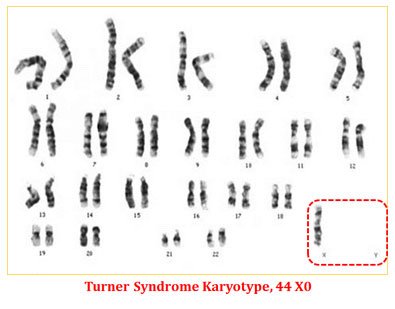
(image source: wikipedia)
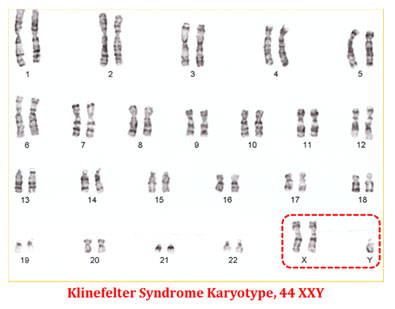
(image source: wikipedia)
Modern methods in the Preparation of Karyotype
@. Fluorescence in-situ Hybridization (FISH) is used in modern research for the preparation of Karyotypes.
@. FISH provide accurate details of the chromosome even at minute scale.
@. FISH preparations of chromosomes are visualized by Fluorescence Microscope

(image source: wikipedia)
<<Back to Molecular Biology Notes

Karyotyping and ideogram for sheep and goat